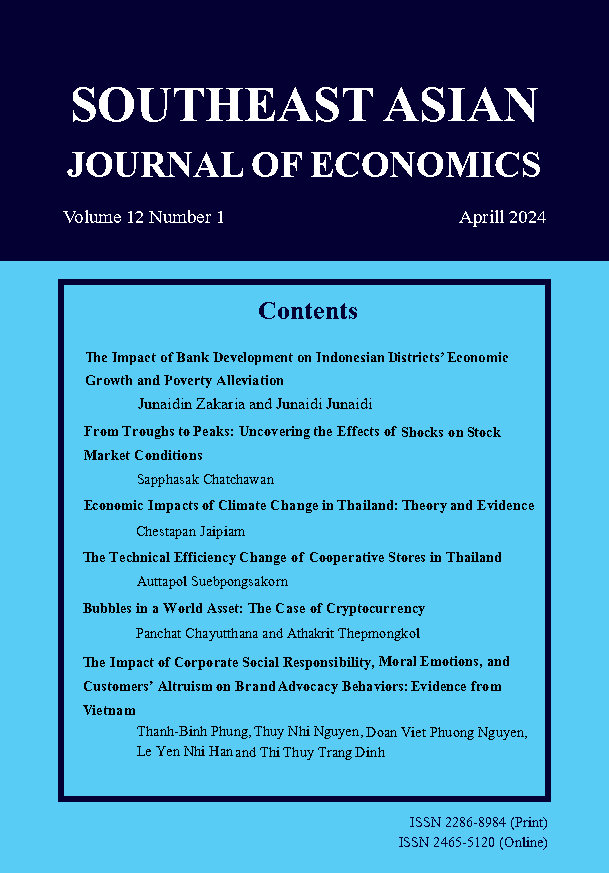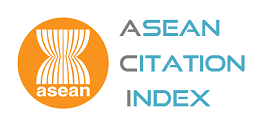Economic Impacts of Climate Change in Thailand: Theory and Evidence
Keywords:
Business cycle, Climate change, Climate shocks, DSGE models, Small open economy, Structural VAR modelsAbstract
Climate change, characterized by not only rising average temperatures but also intensifying extreme weather events such as floods and droughts, poses substantial risks to the production of goods and services. This study investigates the implications of these extreme weather conditions on Thailand’s macroeconomy, utilizing the Standardized Precipitation-Evapotranspiration Index (SPEI) to measure drought conditions. Through the analysis of both the Dynamic Stochastic General Equilibrium (DSGE) and Structural Vector Autoregression (SVAR) models, extreme weather conditions have a significant negative impact on short-run macroeconomic performance, causing disruptions in production and domestic demand while simultaneously driving up agricultural prices. Notably, the counterfactual analyses reveal that policy measures designed to adapt to climate change and enhance labor mobility across sectors markedly alleviate the detrimental economic consequences of climatic extremes.Consequently, this underscores the pivotal role of adaptive climate and labor migration policies in mitigating the adverse impacts of climate change on Thailand’s macroeconomy.
References
Amatyakul, P., Apaitan, T., Hiruntiaranakul, S., and Nookhwun, N. (2021). Revisiting Thailand’s
Monetary Policy Model for an Integrated Policy Analysis. PIER Discussion Papers 164, Puey
Ungphakorn Institute for Economic Research.
Bremus, F., Dany-Knedlik, G., and Schlaak, T. (2020). Price Stability and Climate Risks: Sensible
Measures for the European Central Bank. DIW Weekly Report, 10(14):205–213.
Brooks, S. P. and Gelman, A. (1998). General Methods for Monitoring Convergence of Iterative Simulations.
Journal of Computational and Graphical Statistics, 7(4):434–455. Publisher: Taylor &
Francis.
Buckle, R. A., Kim, K., Kirkham, H., McLellan, N., and Sharma, J. (2007). A structural VAR business
cycle model for a volatile small open economy. Economic Modelling, 24(6):990–1017.
Cleveland, R. B., Cleveland, W. S., and Terpenning, I. (1990). STL: A Seasonal-Trend Decomposition
Procedure Based on Loess. Journal of Official Statistics, 6(1):3. ISBN: 0282-423X Publisher:
Statistics Sweden (SCB).
Couharde, C., Olivier, Damette, R´emi, Generoso, and Kamiar, Mohaddes (2019). Reexamining the
growth effects of ENSO: the role of local weather conditions. Technical Report 2019-27, Bureau
d’Economie Th´eorique et Appliqu´ee, UDS, Strasbourg.
Cushman, D. O. and Zha, T. (1997). Identifying monetary policy in a small open economy under flexible
exchange rates. Journal of Monetary Economics, 39(3):433–448.
Eckstein, D., K¨unzel, V., and Sch¨afer, L. (2021). The global climate risk index 2021. Bonn: Germanwatch.
Gallic, E. and Vermandel, G. (2020). Weather shocks. European Economic Review, 124:103409.
Golosov, M., Hassler, J., Krusell, P., and Tsyvinski, A. (2014). Optimal Taxes on Fossil Fuel in General
Equilibrium. Econometrica, 82(1):41–88. Publisher: John Wiley & Sons, Ltd.
Hashimoto, R. and Sudo, N. (2022). Transmission of Flood Damage to the Real Economy and Financial
Intermediation: Simulation Analysis using a DSGE Model. Technical Report 22-E-5, Bank of Japan.
Jirophat, C., Manopimoke, P., and Suwanik, S. (2022). The Macroeconomic Effects of Climate Shocks in
Thailand. Discussion Paper 188, Puey Ungphakorn Institute for Economic Research.
Kamber, G., McDonald, C., and Price, G. (2013). Drying out: Investigating the economic effects of
drought in New Zealand. Reserve Bank of New Zealand Analytical Notes series AN2013/02, Reserve
Bank of New Zealand.
Luangaram, P. and Wongpunya, N. (2022). Exploring the Role of Exchange Rate in Inflation Targeting:
Evidence from Thailand. Discussion Paper 179, Puey Ungphakorn Institute for Economic Research.
McKee, T. B., Doesken, N. J., and Kleist, J. (1993). The relationship of drought frequency and duration
to time scales. In Proceedings of the 8th Conference on Applied Climatology, volume 17, pages
–183. Boston. Issue: 22.
Nordhaus, W. D. (1977). Economic Growth and Climate: The Carbon Dioxide Problem. The American
Economic Review, 67(1):341–346. Publisher: American Economic Association.
Nordhaus, W. D. (1991). To Slow or Not to Slow: The Economics of The Greenhouse Effect. The
Economic Journal, 101(407):920–937.
Palmer, W. C. (1965). Meteorological Drought. U.S. Department of Commerce, Weather Bureau. Issue:
v. 30.
Phrommin, K. (2018). Monetary Policy Analysis under Headline and Core Inflation Targeting in Thailand.
Thailand and The World Economy, 36(2):1–31. Section: Research Article.
Pindyck, R. S. (2013). Climate Change Policy: What Do the Models Tell Us? Journal of Economic
Literature, 51(3):860–72.
Schmitt-Groh´e, S. and Uribe, M. (2003). Closing small open economy models. Journal of International
Economics, 61(1):163–185.
Smets, F. and Wouters, R. (2007). Shocks and Frictions in US Business Cycles: A Bayesian DSGE
Approach. American Economic Review, 97(3):586–606.
Tanboon, S. (2008). The Bank of Thailand Structural Model for Policy Analysis. Technical Report
-06, Monetary Policy Group, Bank of Thailand.
Vicente-Serrano, S. M., Beguer´ıa, S., and L´opez-Moreno, J. I. (2010). A Multiscalar Drought Index
Sensitive to Global Warming: The Standardized Precipitation Evapotranspiration Index. Journal
of Climate, 23(7):1696–1718. Place: Boston MA, USA Publisher: American Meteorological Society.
Wannapan, S., Chaiboonsri, C., and Sriboonchitta, S. (2018). Application of the Bayesian DSGE model
to the international tourism sector: evidence from Thailand’s economic cycle. WIT Transactions
on Ecology and the Environment, 227:257–268. ISBN: 1743-3541 Publisher: WIT Press.
Downloads
Published
How to Cite
Issue
Section
Categories
License
Copyright (c) 2024 SOUTHEAST ASIAN JOURNAL OF ECONOMICS

This work is licensed under a Creative Commons Attribution-NonCommercial-NoDerivatives 4.0 International License.
The submission of a manuscript implies that the paper is an original work and has not been published elsewhere. The author(s) authorize the journal to reproduce or distribute the paper in printed or other electronic forms.







